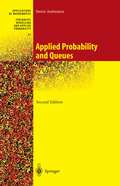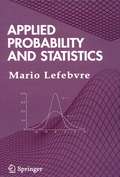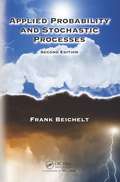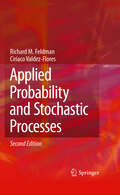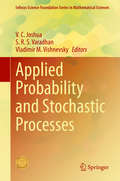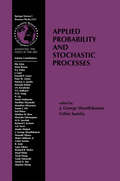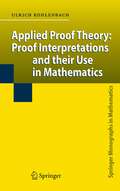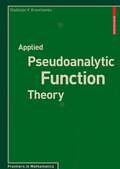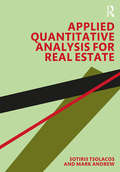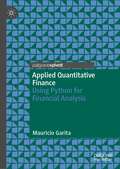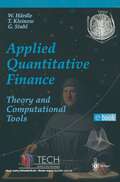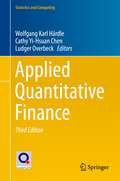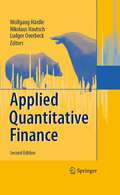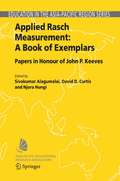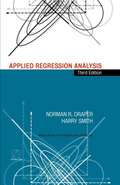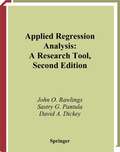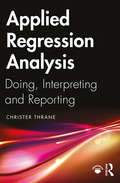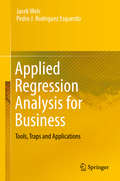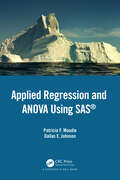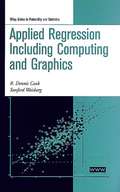- Table View
- List View
Applied Probability and Queues (Stochastic Modelling and Applied Probability #51)
by Soeren Asmussen"This book is a highly recommendable survey of mathematical tools and results in applied probability with special emphasis on queueing theory....The second edition at hand is a thoroughly updated and considerably expended version of the first edition.... This book and the way the various topics are balanced are a welcome addition to the literature. It is an indispensable source of information for both advanced graduate students and researchers." --MATHEMATICAL REVIEWS
Applied Probability and Statistics
by Mario LefebvreThis book moves systematically through the topic of applied probability from an introductory chapter to such topics as random variables and vectors, stochastic processes, estimation, testing and regression. The topics are well chosen and the presentation is enriched by many examples from real life. Each chapter concludes with many original, solved and unsolved problems and hundreds of multiple choice questions, enabling those unfamiliar with the topics to master them. Additionally appealing are historical notes on the mathematicians mentioned throughout, and a useful bibliography. A distinguishing character of the book is its thorough and succinct handling of the varied topics.
Applied Probability and Stochastic Processes
by Frank BeicheltApplied Probability and Stochastic Processes, Second Edition presents a self-contained introduction to elementary probability theory and stochastic processes with a special emphasis on their applications in science, engineering, finance, computer science, and operations research. It covers the theoretical foundations for modeling time-dependent random phenomena in these areas and illustrates applications through the analysis of numerous practical examples. The author draws on his 50 years of experience in the field to give your students a better understanding of probability theory and stochastic processes and enable them to use stochastic modeling in their work. New to the Second Edition Completely rewritten part on probability theory—now more than double in size New sections on time series analysis, random walks, branching processes, and spectral analysis of stationary stochastic processes Comprehensive numerical discussions of examples, which replace the more theoretically challenging sections Additional examples, exercises, and figures Presenting the material in a student-friendly, application-oriented manner, this non-measure theoretic text only assumes a mathematical maturity that applied science students acquire during their undergraduate studies in mathematics. Many exercises allow students to assess their understanding of the topics. In addition, the book occasionally describes connections between probabilistic concepts and corresponding statistical approaches to facilitate comprehension. Some important proofs and challenging examples and exercises are also included for more theoretically interested readers.
Applied Probability and Stochastic Processes
by Frank BeicheltApplied Probability and Stochastic Processes, Second Edition presents a self-contained introduction to elementary probability theory and stochastic processes with a special emphasis on their applications in science, engineering, finance, computer science, and operations research. It covers the theoretical foundations for modeling time-dependent random phenomena in these areas and illustrates applications through the analysis of numerous practical examples. The author draws on his 50 years of experience in the field to give your students a better understanding of probability theory and stochastic processes and enable them to use stochastic modeling in their work. New to the Second Edition Completely rewritten part on probability theory—now more than double in size New sections on time series analysis, random walks, branching processes, and spectral analysis of stationary stochastic processes Comprehensive numerical discussions of examples, which replace the more theoretically challenging sections Additional examples, exercises, and figures Presenting the material in a student-friendly, application-oriented manner, this non-measure theoretic text only assumes a mathematical maturity that applied science students acquire during their undergraduate studies in mathematics. Many exercises allow students to assess their understanding of the topics. In addition, the book occasionally describes connections between probabilistic concepts and corresponding statistical approaches to facilitate comprehension. Some important proofs and challenging examples and exercises are also included for more theoretically interested readers.
Applied Probability and Stochastic Processes
by Richard M. Feldman Ciriaco Valdez-FloresThis book is a result of teaching stochastic processes to junior and senior undergr- uates and beginning graduate students over many years. In teaching such a course, we have realized a need to furnish students with material that gives a mathematical presentation while at the same time providing proper foundations to allow students to build an intuitive feel for probabilistic reasoning. We have tried to maintain a b- ance in presenting advanced but understandable material that sparks an interest and challenges students, without the discouragement that often comes as a consequence of not understanding the material. Our intent in this text is to develop stochastic p- cesses in an elementary but mathematically precise style and to provide suf?cient examples and homework exercises that will permit students to understand the range of application areas for stochastic processes. We also practice active learning in the classroom. In other words, we believe that the traditional practice of lecturing continuously for 50 to 75 minutes is not a very effective method for teaching. Students should somehow engage in the subject m- ter during the teaching session. One effective method for active learning is, after at most 20 minutes of lecture, to assign a small example problem for the students to work and one important tool that the instructor can utilize is the computer. So- times we are fortunate to lecture students in a classroom containing computers with a spreadsheet program, usually Microsoft’s Excel.
Applied Probability and Stochastic Processes (Infosys Science Foundation Series)
by V. C. Joshua S. R. S. Varadhan Vladimir M. VishnevskyThis book gathers selected papers presented at the International Conference on Advances in Applied Probability and Stochastic Processes, held at CMS College, Kerala, India, on 7–10 January 2019. It showcases high-quality research conducted in the field of applied probability and stochastic processes by focusing on techniques for the modelling and analysis of systems evolving with time. Further, it discusses the applications of stochastic modelling in queuing theory, reliability, inventory, financial mathematics, operations research, and more. This book is intended for a broad audience, ranging from researchers interested in applied probability, stochastic modelling with reference to queuing theory, inventory, and reliability, to those working in industries such as communication and computer networks, distributed information systems, next-generation communication systems, intelligent transportation networks, and financial markets.
Applied Probability and Stochastic Processes (International Series in Operations Research & Management Science #19)
by J. George Shanthikumar Ushio SumitaApplied Probability and Stochastic Processes is an edited work written in honor of Julien Keilson. This volume has attracted a host of scholars in applied probability, who have made major contributions to the field, and have written survey and state-of-the-art papers on a variety of applied probability topics, including, but not limited to: perturbation method, time reversible Markov chains, Poisson processes, Brownian techniques, Bayesian probability, optimal quality control, Markov decision processes, random matrices, queueing theory and a variety of applications of stochastic processes. The book has a mixture of theoretical, algorithmic, and application chapters providing examples of the cutting-edge work that Professor Keilson has done or influenced over the course of his highly-productive and energetic career in applied probability and stochastic processes. The book will be of interest to academic researchers, students, and industrial practitioners who seek to use the mathematics of applied probability in solving problems in modern society.
Applied Proof Theory: Proof Interpretations and their Use in Mathematics (Springer Monographs in Mathematics)
by Ulrich KohlenbachThis is the first treatment in book format of proof-theoretic transformations - known as proof interpretations - that focuses on applications to ordinary mathematics. It covers both the necessary logical machinery behind the proof interpretations that are used in recent applications as well as – via extended case studies – carrying out some of these applications in full detail. This subject has historical roots in the 1950s. This book for the first time tells the whole story.
Applied Pseudoanalytic Function Theory (Frontiers in Mathematics)
by Vladislav V. KravchenkoPseudoanalytic function theory generalizes and preserves many crucial features of complex analytic function theory. The Cauchy-Riemann system is replaced by a much more general first-order system with variable coefficients which turns out to be closely related to important equations of mathematical physics. This relation supplies powerful tools for studying and solving Schrödinger, Dirac, Maxwell, Klein-Gordon and other equations with the aid of complex-analytic methods. The book is dedicated to these recent developments in pseudoanalytic function theory and their applications as well as to multidimensional generalizations. It is directed to undergraduates, graduate students and researchers interested in complex-analytic methods, solution techniques for equations of mathematical physics, partial and ordinary differential equations.
Applied Quantitative Analysis for Real Estate
by Sotiris Tsolacos Mark AndrewTo fully function in today’s global real estate industry, students and professionals increasingly need to understand how to implement essential and cutting-edge quantitative techniques. This book presents an easy-to-read guide to applying quantitative analysis in real estate aimed at non-cognate undergraduate and masters students, and meets the requirements of modern professional practice. Through case studies and examples illustrating applications using data sourced from dedicated real estate information providers and major firms in the industry, the book provides an introduction to the foundations underlying statistical data analysis, common data manipulations and understanding descriptive statistics, before gradually building up to more advanced quantitative analysis, modelling and forecasting of real estate markets. Our examples and case studies within the chapters have been specifically compiled for this book and explicitly designed to help the reader acquire a better understanding of the quantitative methods addressed in each chapter. Our objective is to equip readers with the skills needed to confidently carry out their own quantitative analysis and be able to interpret empirical results from academic work and practitioner studies in the field of real estate and in other asset classes. Both undergraduate and masters level students, as well as real estate analysts in the professions, will find this book to be essential reading.
Applied Quantitative Analysis for Real Estate
by Sotiris Tsolacos Mark AndrewTo fully function in today’s global real estate industry, students and professionals increasingly need to understand how to implement essential and cutting-edge quantitative techniques. This book presents an easy-to-read guide to applying quantitative analysis in real estate aimed at non-cognate undergraduate and masters students, and meets the requirements of modern professional practice. Through case studies and examples illustrating applications using data sourced from dedicated real estate information providers and major firms in the industry, the book provides an introduction to the foundations underlying statistical data analysis, common data manipulations and understanding descriptive statistics, before gradually building up to more advanced quantitative analysis, modelling and forecasting of real estate markets. Our examples and case studies within the chapters have been specifically compiled for this book and explicitly designed to help the reader acquire a better understanding of the quantitative methods addressed in each chapter. Our objective is to equip readers with the skills needed to confidently carry out their own quantitative analysis and be able to interpret empirical results from academic work and practitioner studies in the field of real estate and in other asset classes. Both undergraduate and masters level students, as well as real estate analysts in the professions, will find this book to be essential reading.
Applied Quantitative Finance: Using Python for Financial Analysis
by Mauricio GaritaThis book provides both conceptual knowledge of quantitative finance and a hands-on approach to using Python. It begins with a description of concepts prior to the application of Python with the purpose of understanding how to compute and interpret results. This book offers practical applications in the field of finance concerning Python, a language that is more and more relevant in the financial arena due to big data. This will lead to a better understanding of finance as it gives a descriptive process for students, academics and practitioners.
Applied Quantitative Finance: Theory and Computational Tools
by W. Härdle T. Kleinow G. StahlThis book presents solutions for many practical problems in quantitative finance. The e-book design of the text connects theory and computational tools in an innovative way. All "quantlets" for calculation of examples in the text are executable on an XploRe Quantlet Server (XQS) and can be modified by the reader via the internet. The electronic edition can be downloaded from the web.
Applied Quantitative Finance (Statistics and Computing)
by Wolfgang Karl Härdle Cathy Yi-Hsuan Chen Ludger OverbeckThis volume provides practical solutions and introduces recent theoretical developments in risk management, pricing of credit derivatives, quantification of volatility and copula modeling. This third edition is devoted to modern risk analysis based on quantitative methods and textual analytics to meet the current challenges in banking and finance. It includes 14 new contributions and presents a comprehensive, state-of-the-art treatment of cutting-edge methods and topics, such as collateralized debt obligations, the high-frequency analysis of market liquidity, and realized volatility.The book is divided into three parts: Part 1 revisits important market risk issues, while Part 2 introduces novel concepts in credit risk and its management along with updated quantitative methods. The third part discusses the dynamics of risk management and includes risk analysis of energy markets and for cryptocurrencies. Digital assets, such as blockchain-based currencies, have become popular but are theoretically challenging when based on conventional methods. Among others, it introduces a modern text-mining method called dynamic topic modeling in detail and applies it to the message board of Bitcoins. The unique synthesis of theory and practice supported by computational tools is reflected not only in the selection of topics, but also in the fine balance of scientific contributions on practical implementation and theoretical concepts. This link between theory and practice offers theoreticians insights into considerations of applicability and, vice versa, provides practitioners convenient access to new techniques in quantitative finance. Hence the book will appeal both to researchers, including master and PhD students, and practitioners, such as financial engineers. The results presented in the book are fully reproducible and all quantlets needed for calculations are provided on an accompanying website.The Quantlet platform quantlet.de, quantlet.com, quantlet.org is an integrated QuantNet environment consisting of different types of statistics-related documents and program codes. Its goal is to promote reproducibility and offer a platform for sharing validated knowledge native to the social web. QuantNet and the corresponding Data-Driven Documents-based visualization allows readers to reproduce the tables, pictures and calculations inside this Springer book.
Applied Quantitative Finance
by Wolfgang Karl Härdle Nikolaus Hautsch Ludger OverbeckRecent years have witnessed a growing importance of quantitative methods in both financial research and industry. This development requires the use of advanced techniques on a theoretical and applied level, especially when it comes to the quantification of risk and the valuation of modern financial products. Applied Quantitative Finance (2nd edition) provides a comprehensive and state-of-the-art treatment of cutting-edge topics and methods. It provides solutions to and presents theoretical developments in many practical problems such as risk management, pricing of credit derivatives, quantification of volatility and copula modelling. The synthesis of theory and practice supported by computational tools is reflected in the selection of topics as well as in a finely tuned balance of scientific contributions on practical implementation and theoretical concepts. This linkage between theory and practice offers theoreticians insights into considerations of applicability and, vice versa, provides practitioners comfortable access to new techniques in quantitative finance. Themes that are dominant in current research and which are presented in this book include among others the valuation of Collaterized Debt Obligations (CDOs), the high-frequency analysis of market liquidity, the pricing of Bermuda options and realized volatility. All Quantlets for the calculation of the given examples are downloadable from the Springer web pages.
Applied Rasch Measurement: Papers in Honour of John P. Keeves (Education in the Asia-Pacific Region: Issues, Concerns and Prospects #4)
by Sivakumar Alagumalai David D. Curtis Njora HungiWhile the primary purpose of the book is a celebration of John’s contributions to the field of measurement, a second and related purpose is to provide a useful resource. We believe that the combination of the developmental history and theory of the method, the examples of its use in practice, some possible future directions, and software and data files will make this book a valuable resource for teachers and scholars of the Rasch method. This book is a tribute to Professor John P Keeves for the advocacy of the Rasch model in Australia. Happy 80th birthday John! xii There are good introductory texts on Item Response Theory, Objective Measurement and the Rasch model. However, for a beginning researcher keen on utilising the potentials of the Rasch model, theoretical discussions of test theory and associated indices do not meet their pragmatic needs. Furthermore, many researchers in measurement still have little or no knowledge of the features of the Rasch model and its use in a variety of situations and disciplines. This book attempts to describe the underlying axioms of test theory, and, in particular, the concepts of objective measurement and the Rasch model, and then link theory to practice. We have been introduced to the various models of test theory during our graduate days. It was time for us to share with those keen in the field of measurement in education, psychology and the social sciences the theoretical and practical aspects of objective measurement.
Applied Regression Analysis (Wiley Series in Probability and Statistics #326)
by Norman R. Draper Harry SmithAn outstanding introduction to the fundamentals of regression analysis-updated and expanded The methods of regression analysis are the most widely used statistical tools for discovering the relationships among variables. This classic text, with its emphasis on clear, thorough presentation of concepts and applications, offers a complete, easily accessible introduction to the fundamentals of regression analysis. Assuming only a basic knowledge of elementary statistics, Applied Regression Analysis, Third Edition focuses on the fitting and checking of both linear and nonlinear regression models, using small and large data sets, with pocket calculators or computers. This Third Edition features separate chapters on multicollinearity, generalized linear models, mixture ingredients, geometry of regression, robust regression, and resampling procedures. Extensive support materials include sets of carefully designed exercises with full or partial solutions and a series of true/false questions with answers. All data sets used in both the text and the exercises can be found on the companion disk at the back of the book. For analysts, researchers, and students in university, industrial, and government courses on regression, this text is an excellent introduction to the subject and an efficient means of learning how to use a valuable analytical tool. It will also prove an invaluable reference resource for applied scientists and statisticians.
Applied Regression Analysis (Wiley Series in Probability and Statistics #326)
by Norman R. Draper Harry SmithAn outstanding introduction to the fundamentals of regression analysis-updated and expanded The methods of regression analysis are the most widely used statistical tools for discovering the relationships among variables. This classic text, with its emphasis on clear, thorough presentation of concepts and applications, offers a complete, easily accessible introduction to the fundamentals of regression analysis. Assuming only a basic knowledge of elementary statistics, Applied Regression Analysis, Third Edition focuses on the fitting and checking of both linear and nonlinear regression models, using small and large data sets, with pocket calculators or computers. This Third Edition features separate chapters on multicollinearity, generalized linear models, mixture ingredients, geometry of regression, robust regression, and resampling procedures. Extensive support materials include sets of carefully designed exercises with full or partial solutions and a series of true/false questions with answers. All data sets used in both the text and the exercises can be found on the companion disk at the back of the book. For analysts, researchers, and students in university, industrial, and government courses on regression, this text is an excellent introduction to the subject and an efficient means of learning how to use a valuable analytical tool. It will also prove an invaluable reference resource for applied scientists and statisticians.
Applied Regression Analysis: A Research Tool (Springer Texts in Statistics)
by John O. Rawlings Sastry G. Pantula David A. DickeyLeast squares estimation, when used appropriately, is a powerful research tool. A deeper understanding of the regression concepts is essential for achieving optimal benefits from a least squares analysis. This book builds on the fundamentals of statistical methods and provides appropriate concepts that will allow a scientist to use least squares as an effective research tool.Applied Regression Analysis is aimed at the scientist who wishes to gain a working knowledge of regression analysis. The basic purpose of this book is to develop an understanding of least squares and related statistical methods without becoming excessively mathematical. It is the outgrowth of more than 30 years of consulting experience with scientists and many years of teaching an applied regression course to graduate students. Applied Regression Analysis serves as an excellent text for a service course on regression for non-statisticians and as a reference for researchers. It also provides a bridge between a two-semester introduction to statistical methods and a thoeretical linear models course.Applied Regression Analysis emphasizes the concepts and the analysis of data sets. It provides a review of the key concepts in simple linear regression, matrix operations, and multiple regression. Methods and criteria for selecting regression variables and geometric interpretations are discussed. Polynomial, trigonometric, analysis of variance, nonlinear, time series, logistic, random effects, and mixed effects models are also discussed. Detailed case studies and exercises based on real data sets are used to reinforce the concepts. The data sets used in the book are available on the Internet.
Applied Regression Analysis: Doing, Interpreting and Reporting
by Christer ThraneThis book is an introduction to regression analysis, focusing on the practicalities of doing regression analysis on real-life data. Contrary to other textbooks on regression, this book is based on the idea that you do not necessarily need to know much about statistics and mathematics to get a firm grip on regression and perform it to perfection. This non-technical point of departure is complemented by practical examples of real-life data analysis using statistics software such as Stata, R and SPSS. Parts 1 and 2 of the book cover the basics, such as simple linear regression, multiple linear regression, how to interpret the output from statistics programs, significance testing and the key regression assumptions. Part 3 deals with how to practically handle violations of the classical linear regression assumptions, regression modeling for categorical y-variables and instrumental variable (IV) regression. Part 4 puts the various purposes of, or motivations for, regression into the wider context of writing a scholarly report and points to some extensions to related statistical techniques. This book is written primarily for those who need to do regression analysis in practice, and not only to understand how this method works in theory. The book’s accessible approach is recommended for students from across the social sciences.
Applied Regression Analysis: Doing, Interpreting and Reporting
by Christer ThraneThis book is an introduction to regression analysis, focusing on the practicalities of doing regression analysis on real-life data. Contrary to other textbooks on regression, this book is based on the idea that you do not necessarily need to know much about statistics and mathematics to get a firm grip on regression and perform it to perfection. This non-technical point of departure is complemented by practical examples of real-life data analysis using statistics software such as Stata, R and SPSS. Parts 1 and 2 of the book cover the basics, such as simple linear regression, multiple linear regression, how to interpret the output from statistics programs, significance testing and the key regression assumptions. Part 3 deals with how to practically handle violations of the classical linear regression assumptions, regression modeling for categorical y-variables and instrumental variable (IV) regression. Part 4 puts the various purposes of, or motivations for, regression into the wider context of writing a scholarly report and points to some extensions to related statistical techniques. This book is written primarily for those who need to do regression analysis in practice, and not only to understand how this method works in theory. The book’s accessible approach is recommended for students from across the social sciences.
Applied Regression Analysis for Business: Tools, Traps and Applications
by Jacek Welc Pedro J. EsquerdoThis book offers hands-on statistical tools for business professionals by focusing on the practical application of a single-equation regression. The authors discuss commonly applied econometric procedures, which are useful in building regression models for economic forecasting and supporting business decisions. A significant part of the book is devoted to traps and pitfalls in implementing regression analysis in real-world scenarios. The book consists of nine chapters, the final two of which are fully devoted to case studies. Today's business environment is characterised by a huge amount of economic data. Making successful business decisions under such data-abundant conditions requires objective analytical tools, which can help to identify and quantify multiple relationships between dozens of economic variables. Single-equation regression analysis, which is discussed in this book, is one such tool. The book offers a valuable guide and is relevant in various areas of economic and business analysis, including marketing, financial and operational management.
Applied Regression and ANOVA Using SAS
by Patricia F. Moodie Dallas E. JohnsonApplied Regression and ANOVA Using SAS® has been written specifically for non-statisticians and applied statisticians who are primarily interested in what their data are revealing. Interpretation of results are key throughout this intermediate-level applied statistics book. The authors introduce each method by discussing its characteristic features, reasons for its use, and its underlying assumptions. They then guide readers in applying each method by suggesting a step-by-step approach while providing annotated SAS programs to implement these steps.Those unfamiliar with SAS software will find this book helpful as SAS programming basics are covered in the first chapter. Subsequent chapters give programming details on a need-to-know basis. Experienced as well as entry-level SAS users will find the book useful in applying linear regression and ANOVA methods, as explanations of SAS statements and options chosen for specific methods are provided.Features:•Statistical concepts presented in words without matrix algebra and calculus•Numerous SAS programs, including examples which require minimum programming effort to produce high resolution publication-ready graphics•Practical advice on interpreting results in light of relatively recent views on threshold p-values, multiple testing, simultaneous confidence intervals, confounding adjustment, bootstrapping, and predictor variable selection•Suggestions of alternative approaches when a method’s ideal inference conditions are unreasonable for one’s dataThis book is invaluable for non-statisticians and applied statisticians who analyze and interpret real-world data. It could be used in a graduate level course for non-statistical disciplines as well as in an applied undergraduate course in statistics or biostatistics.
Applied Regression and ANOVA Using SAS
by Patricia F. Moodie Dallas E. JohnsonApplied Regression and ANOVA Using SAS® has been written specifically for non-statisticians and applied statisticians who are primarily interested in what their data are revealing. Interpretation of results are key throughout this intermediate-level applied statistics book. The authors introduce each method by discussing its characteristic features, reasons for its use, and its underlying assumptions. They then guide readers in applying each method by suggesting a step-by-step approach while providing annotated SAS programs to implement these steps.Those unfamiliar with SAS software will find this book helpful as SAS programming basics are covered in the first chapter. Subsequent chapters give programming details on a need-to-know basis. Experienced as well as entry-level SAS users will find the book useful in applying linear regression and ANOVA methods, as explanations of SAS statements and options chosen for specific methods are provided.Features:•Statistical concepts presented in words without matrix algebra and calculus•Numerous SAS programs, including examples which require minimum programming effort to produce high resolution publication-ready graphics•Practical advice on interpreting results in light of relatively recent views on threshold p-values, multiple testing, simultaneous confidence intervals, confounding adjustment, bootstrapping, and predictor variable selection•Suggestions of alternative approaches when a method’s ideal inference conditions are unreasonable for one’s dataThis book is invaluable for non-statisticians and applied statisticians who analyze and interpret real-world data. It could be used in a graduate level course for non-statistical disciplines as well as in an applied undergraduate course in statistics or biostatistics.
Applied Regression Including Computing and Graphics (Wiley Series in Probability and Statistics #488)
by R. Dennis Cook Sanford WeisbergA step-by-step guide to computing and graphics in regression analysis In this unique book, leading statisticians Dennis Cook and Sanford Weisberg expertly blend regression fundamentals and cutting-edge graphical techniques. They combine and up- date most of the material from their widely used earlier work, An Introduction to Regression Graphics, and Weisberg's Applied Linear Regression; incorporate the latest in statistical graphics, computing, and regression models; and wind up with a modern, fully integrated approach to one of the most important tools of data analysis. In 23 concise, easy-to-digest chapters, the authors present:? A wealth of simple 2D and 3D graphical techniques, helping visualize results through graphs * An improved version of the user-friendly Arc software, which lets readers promptly implement new ideas * Complete coverage of regression models, including logistic regression and generalized linear models * More than 300 figures, easily reproducible on the computer * Numerous examples and problems based on real data * A companion Web site featuring free software and advice, available at www.wiley.com/mathem atics Accessible, self-contained, and fully referenced, Applied Regression Including Computing and Graphics assumes only a first course in basic statistical methods and provides a bona fide user manual for the Arc software. It is an invaluable resource for anyone interested in learning how to analyze regression problems with confidence and depth.
